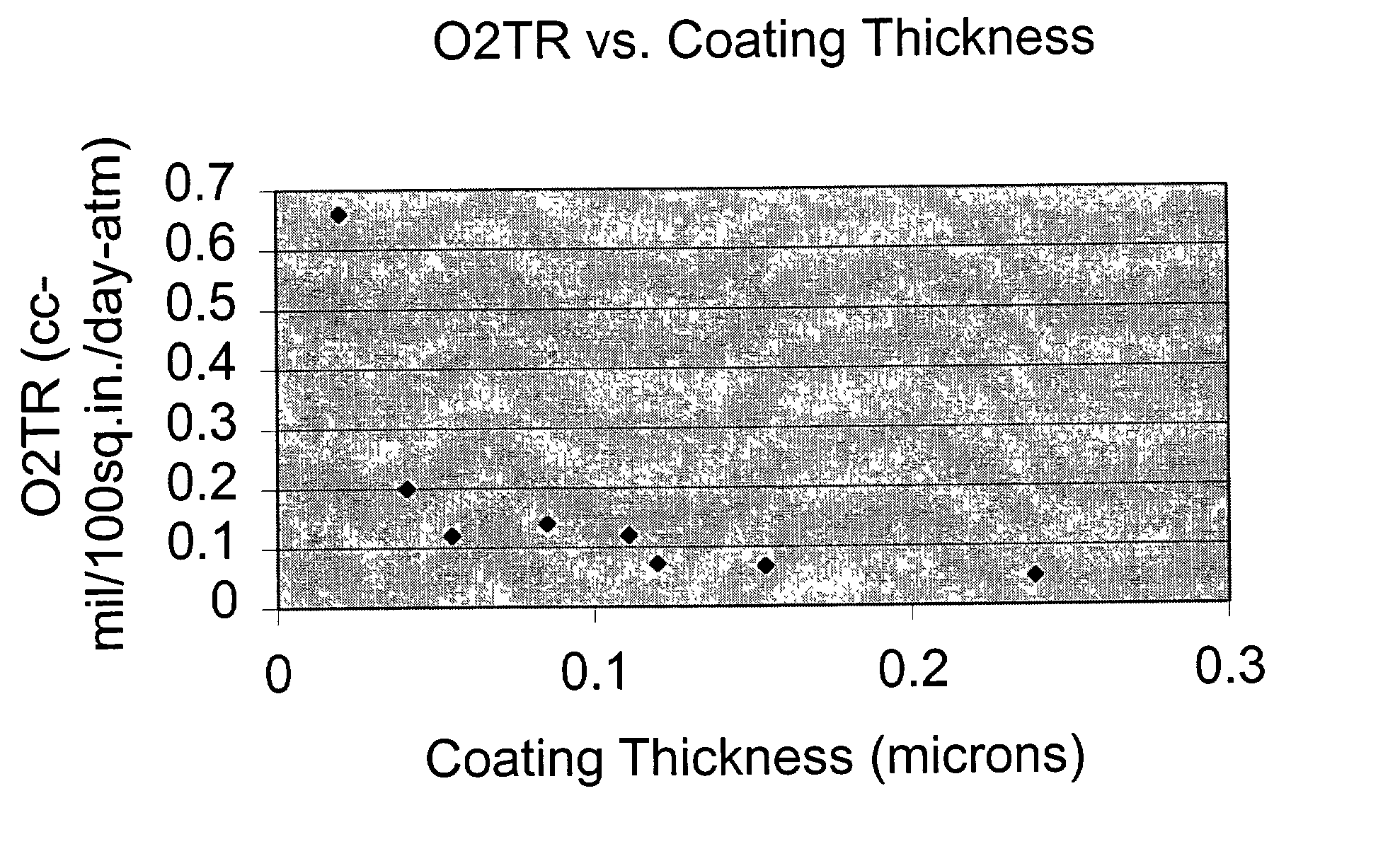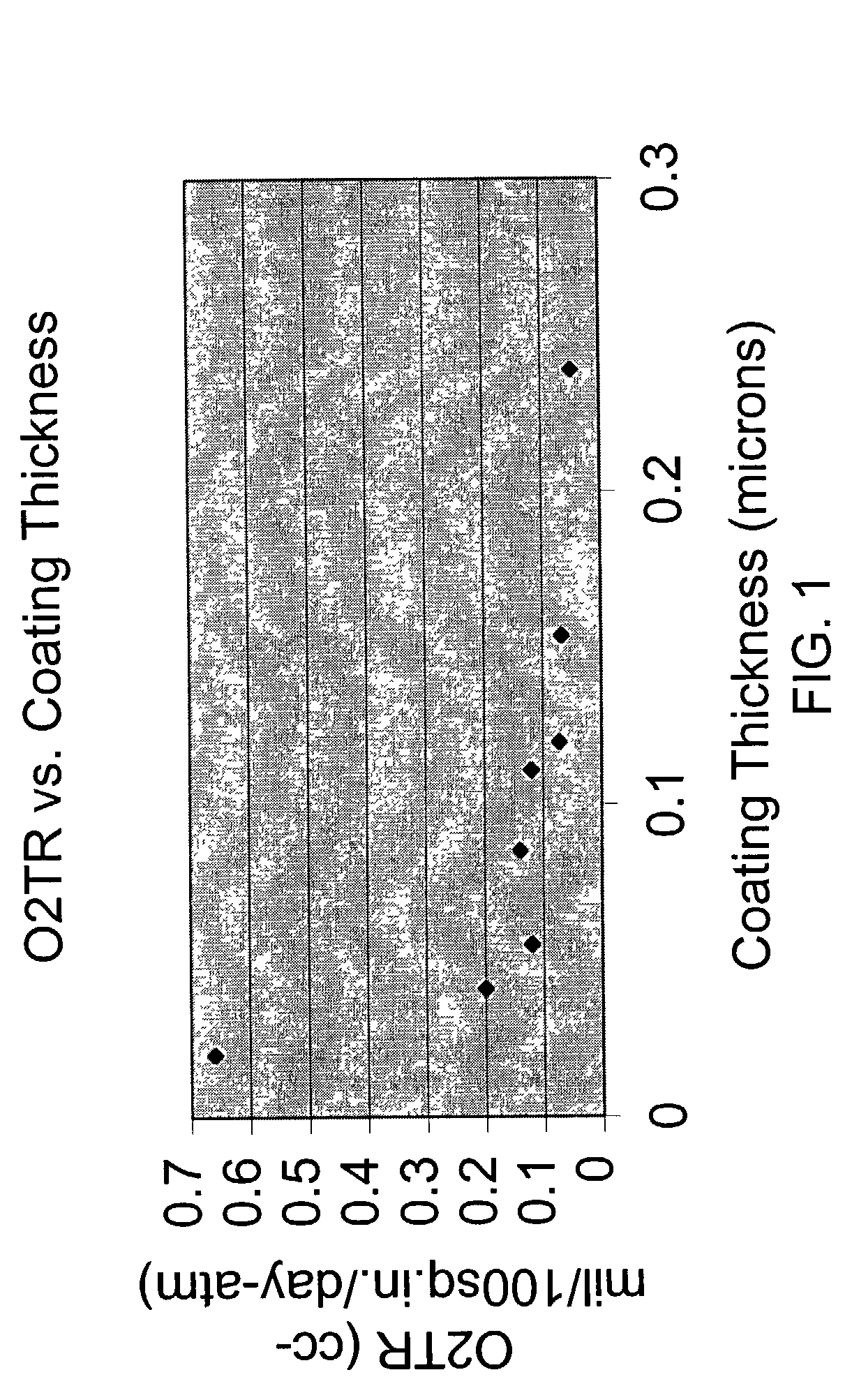Oxygen barrier coating and coated film
a technology of oxygen barrier coating and coating film, which is applied in the direction of synthetic resin layered products, ornamental textile articles, cellulosic plastic layered products, etc., can solve the problems of insufficient transparency, high cost, and numerous limitations of known barrier coatings
- Summary
- Abstract
- Description
- Claims
- Application Information
AI Technical Summary
Benefits of technology
Problems solved by technology
Method used
Image
Examples
example series b
[0050] 48 gauge polyester film, both uncoated and coated with a preferred coating according to the present invention (7% PAA / MA, 3% PVOH), was metallized by vacuum deposition of aluminum to an optical density of 2.5, a conventional practice for packaging films. Oxygen transmission rates were measured.
2 Oxygen Permeation Rate Film Type (cc / 100 in.sup.2 / day / atm) Uncoated and metallized average value: 0.080 Coated and metallized average value: 0.014
[0051] Thus, in comparison with uncoated metallized film and typical metallized film having conventional metal-adhesion coatings (which have oxygen barrier properties equivalent to those of uncoated metallized film), metallized films having the coatings of the present invention show dramatically reduced oxygen transmission rates.
example series c
[0052] 12 micron thick polyester film, both uncoated and coated at various extremely low thicknesses with a preferred coating according to the present invention (7% PAA / MA, 3% PVOH), was metallized by vacuum deposition of aluminum to an optical density of 2.5, a conventional practice for packaging films. Oxygen transmission rates were measured.
3 PAA / MA / PVOH Metallized Unmetallized (microns) O2TR (cc / 100 sq. in. / day) O2TR .0108 .118 8.38 .0125 .134 .0162 .134 .0204 .134 6.86 .0292 .080 .0294 .070 4.67 .0366 .068 .0385 .070 .0411 .060 .0438 .056 3.49 .0462 .050 .0517 .068 .0586 .048 .0602 .046 .0612 .049 .0926 .028
[0053] Reference Data:
[0054] Plain 12 micron PET (no coating, no metal): 02TR =9.60 cc / 100 sq.in. / day
[0055] Coated (7% PAA / MA, 3% PVOH, 4% Glyoxal) (@.099 microns) (no metal): 02TR=0.48 cc / 100 sq.in. / day (02TR=0.18 without Glyoxal crosslinker at comparable thickness)
[0056] Metallized 12 micron PET (no coating): 02TR=0.23 cc / 100 sq.in. / day
[0057] Thus, even at dramatically low...
example series d
[0058] A 12 micron polyester film was coated off-line with various thicknesses of a preferred coating according to the present invention (7% PAA / MA, 3% PVOH, no crosslinker). The following data demonstrate the thickness-dependency of the oxygen transmission properties. Transmission properties are seen to be slightly better than for otherwise identical coatings including crosslinkers, demonstrating that the superior moisture-resistance provided by the crosslinker has a slight negative effect on oxygen transmission properties.
PUM
| Property | Measurement | Unit |
|---|---|---|
| thickness | aaaaa | aaaaa |
| weight percent | aaaaa | aaaaa |
| weight percent | aaaaa | aaaaa |
Abstract
Description
Claims
Application Information
 Login to View More
Login to View More - R&D
- Intellectual Property
- Life Sciences
- Materials
- Tech Scout
- Unparalleled Data Quality
- Higher Quality Content
- 60% Fewer Hallucinations
Browse by: Latest US Patents, China's latest patents, Technical Efficacy Thesaurus, Application Domain, Technology Topic, Popular Technical Reports.
© 2025 PatSnap. All rights reserved.Legal|Privacy policy|Modern Slavery Act Transparency Statement|Sitemap|About US| Contact US: help@patsnap.com


